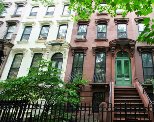 Developers in New York City have had a lot of success luring buyers to high-end apartments with the latest dazzling amenity. Heat reflexology flooring, anyone?
Developers in New York City have had a lot of success luring buyers to high-end apartments with the latest dazzling amenity. Heat reflexology flooring, anyone?
But the feature still most likely to draw people is not something new and shiny but old and reliable: good bones. Many buyers re-entering the real estate market after years on the sidelines are discovering what they’re after in brownstone Brooklyn. In neighborhoods including Fort Greene, Park Slope, Boerum Hill and Red Hook, brokers are besieged by buyers.
“It is amazing,” said Jill Seligson Braver, an associate broker at Brown Harris Stevens. “It is a level of activity I have not seen since 2006-2007. There are so many people looking for brownstone buildings, and there is just no supply.”
Ms. Braver said that when it comes to brownstones, good bones can mean many things: striking period details, ornate moldings, gracious floor plans. But always, they offer a sense of solidity. “Brownstones signify stability,” she said. “Putting roots down in a neighborhood for the long haul.”
It is not uncommon for dozens of people to jam open houses or for bidding wars to leave the listing price in the dust. With so few single-family homes available, buyers have also been eagerly snatching up two- and three-family homes with the goal of converting them to single-family residences.
One of Ms. Braver’s clients, Phil Gennaway, bought a brownstone in Carroll Gardens in 1974 for $50,000. For four decades, the three-story multifamily home has done its duty – serving for a time as a home for Mr. Gennaway and his wife and later as a dependable source of rental income when the couple moved out of the city.
But after incurring some unexpected medical expenses last year, Mr. Gennaway decided that it was time to cash out. He was advised to wait until spring, and on April 30 he listed the building for $1.6 million.
Mr. Gennaway, who has spent many years appraising property values in the city, was surprised by what happened next.
After three group showings and less than one week on the market, he received nine bids – at which point his broker stopped taking offers.
The building is in contract for an amount higher than the asking price. Mr. Gennaway would not reveal the sales price before the deal closed.
Even though the most desirable neighborhoods in Brooklyn were never hit as hard by the recession as less established areas, the current frenzy in the brownstone market is more a reflection of the continuing demand for large spaces.
Jonathan J. Miller, who analyzes market data for Prudential Douglas Elliman, broke down the data on sales of one-, two- and three-family homes and found that prices in northwest Brooklyn were up significantly from this time last year.
In Park Slope by the end of April, the median sales price had jumped nearly 20 percent over the same period last year, to $1.45 million from $1.2 million. The number of sales in the neighborhood is also up: 158 this year compared with 132 last year.
The biggest price increases have been in Boerum Hill – up 60 percent, to $1.7 million from $1.1 million – and Red Hook – up 73 percent, to $825,000 from $475,000, although it is a small neighborhood and only a handful of properties were on the market. In some cases, homes are selling for more than what they might have brought in the heady days of 2007.
Even when the most expensive sales are removed from the calculations, Mr. Miller said, the surge in prices in striking.
“The theory was that when the credit crunch hit, you would see home sizes get smaller,” he said, “and that is not what happened in New York.” Across the city, he added, space is king.
The spiraling prices are being driven, in part, by the lack of supply. Despite the rising demand, no one is building new brownstones. The number of town houses on the market this spring is about the same as it was a year ago.
Banks, still applying much stricter lending standards than in the boom years, have also been slightly more accommodating. Mortgage interest rates are still at record lows, and with prices rising, some buyers who had been on the sidelines waiting for the market to bottom out are taking the plunge.
“There is a lot of money out there,” said Trish Martin, the director of sales in Brooklyn for Halstead Property. But people are cautious, looking to invest in areas that held their value even when times were tough. “We would love to point people to other burgeoning neighborhoods,” she said, “but people have it set in their head that they want a specific neighborhood.”
Mr. Miller says prices are rising the fastest in “core” neighborhoods – the ones that did not see much fluctuation when the economic climate changed.Right now, within those neighborhoods, the greatest demand is for the small clusters of brownstone blocks. Despite the robust spring sales of large homes, studio and one-bedroom apartments in northwest Brooklyn have not proved as resilient, with prices still off from their peak levels.
Rising rents are also driving more people into the sales market. In April, the average rent in Park Slope was up 33 percent from the previous spring, according to a survey by MNS Realty.
In the past, the people hunting for brownstones were often Manhattanites looking for more affordable space across the East River. While such people are still coming to Brooklyn, brokers say, buyers are just as likely to be longtime Brooklyn residents hoping to get out of the rental market or move up the property ladder. Brokers are also seeing an increasing number of new arrivals to New York looking exclusively in Brooklyn.
“A lot of it has to do with the continuing and increasing popularity of the neighborhoods,” said Leslie Marshall, a senior vice president of Corcoran. “You can’t open papers without reading about some style trend that started in Brooklyn or some new restaurant that everyone is talking about. It has been infectious.”
Real estate obsessives have taken note as young Hollywood stars like Maggie Gyllenhaal and Anne Hathaway colonized Brooklyn. With all this buzz, the idea of the borough as consolation for those priced out of Manhattan seems thoroughly passé.
Neely Cather, who just listed her Brooklyn Heights brownstone for $3.65 million, is one of those who were drawn to Brooklyn because they wanted a different vibe than the one they found in Manhattan – less rushed, with the feel of a village, but still urban.
“It is just very difficult to find this kind of neighborhood, where you know everyone on the street,” Ms. Cather said. She described her neighbors as an “open, educated, cultured group.”
The building is being shown by appointment through her broker, Ms. Marshall, at Corcoran. The interest has been intense, she said. Both Manhattanites and Brooklynites have inquired about the property. Ms. Cather said the actress Mary-Louise Parker had stopped by on her house hunt.
The Cathers, who plan to spend time at their place upstate, are not leaving Brooklyn entirely. They bought a condominium nearby at One Brooklyn Bridge Park.
The idea was to have “city living when we are in the city,” she said, and to stay in the neighborhood they love.
Kwadwo Boachie-Adjei, an epidemiologist at Beth Israel Medical Center, is similarly committed to Brooklyn.
He moved to New York from Boston after he had finished graduate school in 2003. At that point, he said, he “joined the long list of renters.” He resolved to save money, search for the right neighborhood and buy something as soon as he could afford it.
“But then the prices skyrocketed,” he said.
He was living in Fort Greene in 2005, and his rent kept rising along with home prices so, despite the risk, he decided to buy a place. As the market neared its peak late that year, he paid $900,000 for a three-family brownstone at 411 Classon Avenue. He lived in the building and rented out two other apartments, but did little in the way of renovations. He is now putting the place on the market for $1.5 million.
The price increase, he believes, has been made possible by all that has developed around the building.
“Over the years, the neighborhood has changed so drastically,” he said. “There are condos being built around the block, and there are now four restaurants on opposite corners, which you see as soon as you walk out of the building.”
As a landlord, he finds tenants often ask him about buying in the neighborhood. Unfortunately, he said, many are frustrated because there is simply so little inventory.
Mr. Boachie-Adjei, gaining confidence after his first purchase, bought another brownstone nearby several years ago for $1.16 million. Unable to secure financing for renovations at the time, he had to let the house sit vacant until he could get the money together.
In a reflection of how strong the market is today, even after some very rough years, his new brownstone – work completed – was recently appraised at $2.5 million. All things considered, he said, it was a very good investment.
{NY Times/Matzav.com Newscenter}











